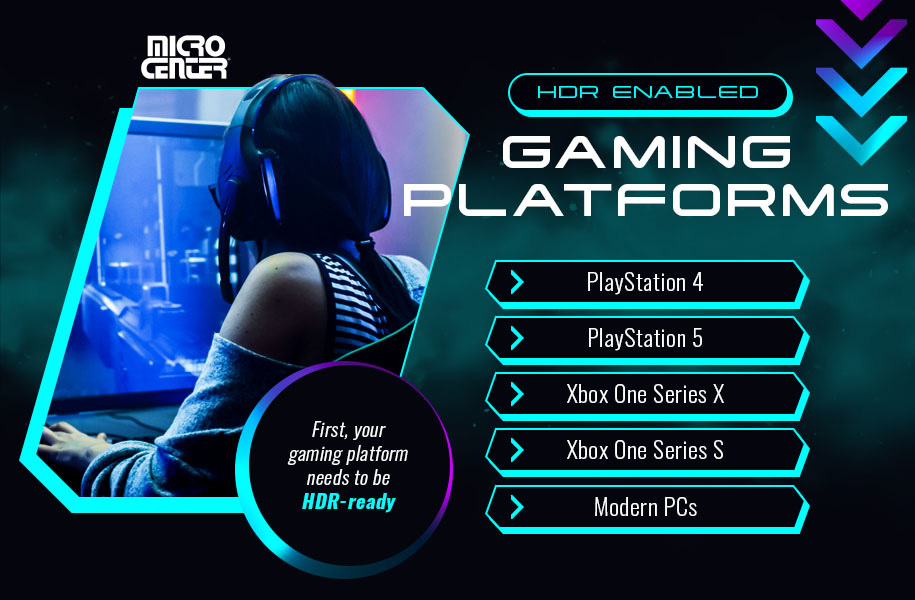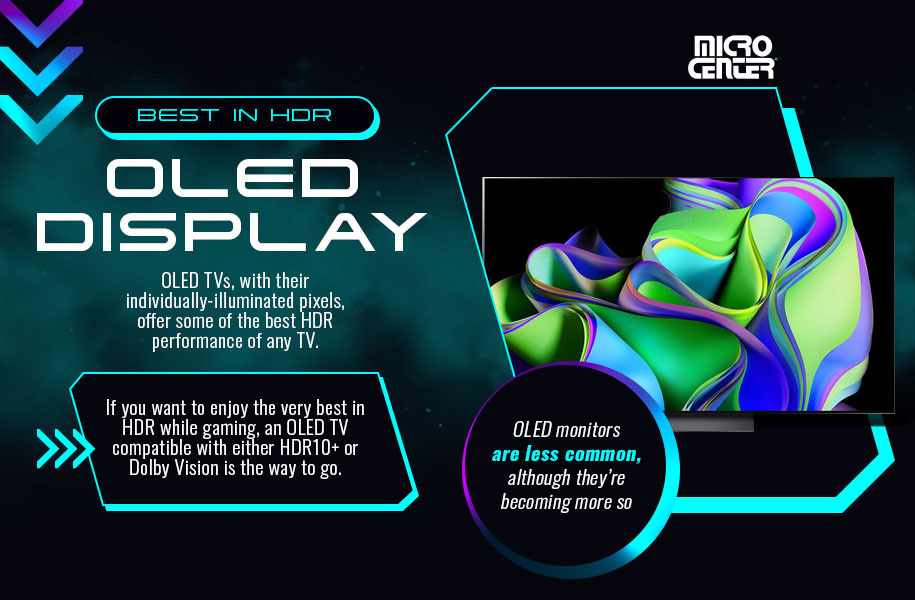What Is HDR Gaming? Everything You Need to Know
In this HDR gaming guide, we'll get you up to speed on this colorful technology and talk about how it can enhance your gaming experience.Buying Guides

Several different factors go into creating a top-tier graphics experience for gamers today. Ultra-high resolutions like 1440p and 4K will show you every little detail, and fast frame rates ensure the whole thing feels buttery-smooth. Increasingly, however, the secret sauce for truly amazing graphics is often color — more specifically, the color- and contrast-boosting technology known as high dynamic range, or HDR.
Basic HDR is available on practically every new TV, as well as an increasing range of PC gaming monitors. However, a little more knowledge about HDR and how it works will help you choose the right HDR display and get the most out of it when you're gaming. In this guide, we'll get you up to speed on this colorful technology and talk about how it can enhance your gaming experience.
What Is HDR in Gaming?
Before we go deep into the nitty-gritty of HDR in gaming, let's get the basics down. These are the three basic things that every gamer should know about HDR:
- HDR is a graphics technology that can deliver much better color, contrast, and visual detail in your games (and other media).
- A broader and more vivid spectrum of colors
- Deeper blacks and brighter whites
- More realistic and detailed images
- HDR uses metadata to produce a more vivid image signal on HDR-enabled displays.
- HDR content encodes extra information into the visual signals that your display receives. This information, called metadata, includes much more complex and sophisticated information about color and brightness than in standard dynamic range (SDR) content.
- If your display and your gaming platform are both HDR-capable, they can interpret the HDR metadata from your content to show you a much wider gamut of colors and significantly improved contrast. (If your display is only capable of SDR, you'll simply see a normal SDR image.)
- HDR is a collection of standards rather than just one.
- HDR10: The baseline HDR standard that any HDR-capable device or content will support. The “10” refers to 10 bits of color, which means that each standard color (red, green, blue) has 1,024 possible shades, rather than the 256 shades that 8-bit SDR color offers. That's over one billion color shades total, compared to the approximately 16 million in SDR. HDR10 content may also be mastered with up to 1,000 nits of brightness.
- HDR10+: An HDR standard that can include up to 4,000 nits of brightness, substantially improving contrast in capable TVs. However, the most significant difference is that HDR10+ metadata is dynamic, rather than static like HDR10 metadata. That means the characteristics of the HDR output can change with the game area, the cutscene, or even the individual frame — a potentially huge difference in quality. The HDR10+ standard is open-source, so any company can license it, but in practice it's often limited to certain manufacturers and streaming services.
- Dolby Vision: A proprietary HDR standard that can be mastered for up to 10,000 nits brightness and 12-bit color, for over 68 billion shades. (Few displays support these levels today, but they're built into the standard for future use.) Dolby Vision is an increasingly popular standard, but since it's a proprietary technology that companies must pay to license, it remains exclusive to some platforms.
When properly implemented and displayed, HDR creates a stunning visual upgrade to your gaming experience. With an HDR-enabled gaming setup, you'll enjoy:
These benefits come from HDR's ability to encode a broader range of colors and brightness levels into its visual output. Next, we'll see how HDR does that.

Here's the simplest way to explain how HDR technology works:
In previous generations of gaming technology, TVs and monitors displayed a relatively narrow range of colors and brightness levels. There was no point in encoding content with more contrast and color information because the display technology to show it off didn't exist in home electronics. Now that TVs and monitors can display a more complete color gamut and more sophisticated contrast, many game studios and other entertainment producers master their content in HDR.
HDR technologies were developed independently by multiple companies, so an array of different HDR standards have always existed. The standards are more consolidated than they used to be, but there are still several that are worth knowing about:
There's also the VESA Certified DisplayHDR™ standards, a set of HDR standards specific to monitors. While the standards we just discussed are content display standards, the VESA DisplayHDR™ standards serve as more of a buyer's guide that helps you know what you're getting when buying a computer monitor. For gamers and other enthusiasts, a DisplayHDR™ 600 monitor is commonly considered a good starting point, but it's worth reading up on the standards in full to see if a higher or lower standard will fit your needs better.
What Do I Need for HDR Gaming?
That all sounds pretty awesome — so how can you tell if your gaming setup is ready for HDR? And if it’s not, what’s the easiest way to get into the world of HDR? These are the three essentials that you’ll need to have on deck for HDR gaming:

1. An HDR-Enabled Gaming Platform
First, your gaming platform needs to be HDR-ready. Some are, and some aren’t, so find your platform on this list and check:
- PS5, Xbox One Series X, Xbox One Series S: If you own one of these, congratulations — your console supports HDR content, and you’ve got access to a wide variety of HDR-enabled games.
- PS4: The PS4 supports HDR, but its selection of HDR-enabled games is more limited than newer consoles.
- Xbox One, Switch: Unfortunately, neither of these consoles or their games support HDR.
- PC: Nearly all modern GPUs support at least basic HDR10. However, the HDR performance of different graphics cards can vary a lot, so check the manufacturer’s specs.
Older platforms and ones that aren’t on this list generally don’t support HDR. Note also that if you want to use a specific higher-level standard like Dolby Vision or HDR10+, check to ensure that it’s available on your platform. Dolby Vision, for example, is currently supported only by the Xbox Series X and Series S.
2. An HDR-Enabled Display
To take advantage of HDR, your TV or PC monitor must have the physical attributes to display its wider color gamut and more advanced contrast. Nearly all TVs today support at least basic HDR10, and many models support higher standards like Dolby Vision and HDR10+. PC monitors have been slower to adopt HDR, but more HDR-enabled monitors are available every day.
Certain features on HDR-enabled displays make a big difference in the image quality. (Skip down to our quick buyer’s guide to learn more about these.) For now, just know that HDR gaming will look best on a monitor with the widest color gamut and highest nit brightness rating you can afford. If you want to play games that use Dolby Vision or HDR10+, make sure your display supports the relevant standards. These days, many support both, but not all do.
One question many gamers have about HDR displays: What role does resolution play in HDR? Although you’ll see phrases like “4K HDR” on display specs often, the truth is that resolution and HDR aren’t closely connected. Resolution measures the number of pixels on screen, while HDR is concerned with the number of colors and depth of contrast. However, HDR produces incredible image quality when combined with high resolutions like 1440p or 4K, so the two features are often advertised together.

3. HDR-Enabled Content
The final third of the equation: You’ll also need content encoded for HDR, which fortunately is pretty easy to come by in today’s world. Most new triple-A games on PC, PS5 and Xbox are mastered in HDR, as is much of the video content on streaming services. Independent games and media may or may not include HDR support.
Generally, older content won’t be HDR-compatible unless it’s been remastered recently. However, there are ways around this, such as the Auto HDR feature on Windows 11 and Xbox Series S/X, which allows you to upscale older content into something similar to HDR color. Results vary with these technologies, but some games can look quite good.
Fortunately, HDR is optional and fully backward compatible, so you can still enjoy HDR-enabled content on a non-enabled device. You just won’t have the benefits of HDR. Likewise, a device with HDR support will have no problem playing non-HDR content if it’s otherwise compatible.
HDR: Limitations and Things to Know
Color Accuracy
The vivid saturation and contrast of an HDR display doesn’t necessarily mean it shows colors accurately (as compared to industry reference standards). If you use your PC monitor for tasks other than gaming or media viewing, particularly visual arts like graphic design or video editing, color accuracy is a key metric in addition to HDR support.
Of course, some of the same metrics that are important for HDR performance (such as a wide color gamut) are also important for these purposes. Plus, if you work with HDR content, your monitor should offer HDR capabilities. However, you’ll definitely want to check model-specific reviews and color calibration information to determine if a monitor offers the accuracy you’re looking for.

Bright Rooms
HDR’s visual improvements are easiest to notice with pleasantly dim lighting in your gaming area. If your TV or monitor is in an area with lots of natural light, you may find that its contrast and color look washed-out even with HDR enabled.
Usually, the best way to deal with this is by creating better control of the lighting in your gaming room. Blackout curtains and soft, warm ambient lighting are a classic solution to ensure your HDR pops like it’s supposed to. Displays with higher nit ratings also tend to perform better in bright rooms than lower-nit displays do, but they still won’t look as good as the same display in a softly lit area.
Limited PC Support
The PC gaming market has taken its time embracing HDR. That’s understandable — the wider variety of gaming PC hardware on the market makes it more challenging for game developers to optimize HDR implementations on PCs. In addition, PC monitors have been slower to adopt features like full-area local dimming and OLED displays, which make a huge difference in HDR quality.
Fortunately, things are headed in the right direction for HDR gaming on PC. More PC monitors than ever are available with HDR support, and graphics card manufacturers are continuously improving their HDR optimization.
Game Implementation
The simple truth is that some games look much better in HDR than others do. This can come down to your system or your display, but just as often it originates in how the game’s visuals are mastered. This can be an issue on both console and PC, but it’s often more pronounced in PC games. Older PC games, in particular, may feature imperfect HDR implementations.
Ultimately, it’s a matter of waiting for technological maturity. The more widespread and standardized HDR becomes, the more sophisticated and reliable its implementations will be. Until then, enjoy HDR on the games where it’s well-optimized, and don’t be afraid to turn off the HDR setting if it’s detrimental to your experience.

Choosing an HDR Display
If you’re looking for the best HDR-capable PC monitor or TV, these are some of the aspects to keep in mind:
- OLED Display: OLED TVs, with their individually-illuminated pixels, offer some of the best HDR performance of any TV. If you want to enjoy the very best in HDR while gaming, an OLED TV compatible with either HDR10+ or Dolby Vision is the way to go. (OLED monitors are less common, although they're becoming more so.)
- Full-Array Local Dimming (FALD): The next best thing to OLED is FALD, a technology you'll find in displays like many of Samsung's QLED TV line. FALD uses independent backlighting zones to create superior contrast, which is critical for HDR. If OLED isn’t right for you but you want robust HDR, consider a FALD display.
- Peak Brightness: Generally, the brighter your display’s backlighting, the more impressive and noticeable the HDR effects will be. A peak brightness of at least 600 nits is a good starting point for most gamers, although a peak of 1,000 nits or more will help you maximize your HDR quality.
- Color Gamut: The best HDR displays will offer as close as possible to 100 percent coverage of the DCI-P3 color space. (DCI-P3 is the color space standard that HDR uses, and is the successor to the standard sRGB color space.) 90 percent coverage is a typical entry-level standard, while higher-level standards often feature 95 percent coverage.
Micro Center’s experts know display technologies inside and out, and we’ll be happy to help you find the perfect HDR solution for your gaming setup! From our huge lineup of HDR gaming monitors to our complete selection of HDR TVs, we've got the right display for you.



.png)
